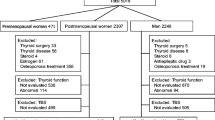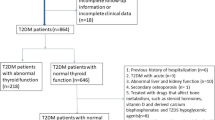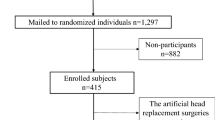Abstract.
Active hyperthyroidism is associated with reduced bone mass. Nevertheless, not all patients show the same risk for developing osteoporosis. Our aim was to analyze some clinical and biochemical potential predictors of low bone mass in hyperthyroid patients. We studied 127 consecutive hyperthyroid patients (110 females, 17 males; aged 42 ± 16 years). Bone mineral density (BMD) was measured by dual X-ray absorptiometry (DXA) at lumbar spine (LS; L2–L4) and femoral neck (FN). Data were expressed as g/cm2 and T-score. Patients were placed into two groups based on recent WHO criteria: Group A, no osteoporosis (n = 98); and group B, lumbar or femoral osteoporosis (n = 29). Study protocol included evaluation of osteoporosis risk factors, anthropometrical variables, thyroid function, and bone turnover markers. Receiver-operating characteristic (ROC) plots for the precision of bone markers and multivariate analysis for the prediction of BMD and osteoporosis were performed. Group B showed greater age and proportion of menopausal females; lower weight, height, and calcium intake; longer duration of menopause; and greater levels of total and bone alkaline phosphatase and of urine hydroxyproline. No differences in thyroid function, osteocalcin, tartrate-resistant acid phosphatase, and type I collagen C-telopeptide (ICTP) were found. The best predictive model accounted for 46% and 62% of the variability of lumbar and femoral BMD respectively and correctly classified 89% of the osteoporotic hyperthyroid patients. No significant difference in ROC plots was observed. It is concluded that hyperthyroid patients with lumbar or femoral osteoporosis show a typical clinical and biochemical profile illustrating that the relationship between BMD and bone markers is better in high turnover states. Classical bone turnover markers show high performance in the evaluation of hyperthyroid bone disease.
Similar content being viewed by others
Author information
Authors and Affiliations
Additional information
Received: 5 May 1997 / Accepted: 5 June 1997
Rights and permissions
About this article
Cite this article
Jódar Gimeno, E., Muñoz-Torres, M., Escobar-Jiménez, F. et al. Identification of Metabolic Bone Disease in Patients with Endogenous Hyperthyroidism: Role of Biological Markers of Bone Turnover. Calcif Tissue Int 61, 370–376 (1997). https://doi.org/10.1007/s002239900350
Issue Date:
DOI: https://doi.org/10.1007/s002239900350




